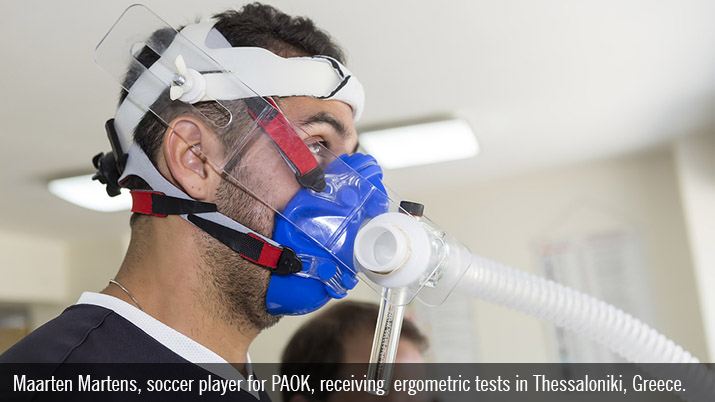The role of data in the sports industry has hit a rapid growth spurt, with major league teams adding analytics experts to their roster of coaches, trainers and medical staff.
The increasing reliance on analytics is widely seen as representing the future of professional sports, and any team not using the technology to its fullest capability could find itself at a competitive disadvantage.
Health informatics is being enlisted in the pursuit of optimal results in the training and treatment of athletes. This allows coaches and trainers to make data-driven decisions, ultimately improving the physical performance of their athletes while reducing the risk of injury.
 “It is rapidly becoming more prevalent as more teams have hired informatics specialists full time to help with roster evaluation and development, as well as training protocols, practice structure, etc.,” said Dr. Kevin Elder, who spent five years as team physician for the NFL’s Tampa Bay Buccaneers and is Assistant Medical Director for the BayCare Medical Group in Tampa, Florida.
“It is rapidly becoming more prevalent as more teams have hired informatics specialists full time to help with roster evaluation and development, as well as training protocols, practice structure, etc.,” said Dr. Kevin Elder, who spent five years as team physician for the NFL’s Tampa Bay Buccaneers and is Assistant Medical Director for the BayCare Medical Group in Tampa, Florida.
For example, Major League Soccer teams have used a tracking system called the miCoach Elite System, which is manufactured by Adidas. Each tracking device contains a GPS tracker, accelerometer, heart rate monitor, magnetometer and gyroscope contained in a small, unobtrusive capsule. The capsule is placed in a protective pocket and positioned on the athlete’s back between their shoulder blades.
“Teams have hired informatics specialists full time to help with roster evaluation and development, as well as training protocols, practice structure, etc.” – Dr. Kevin Elder, Affiliate Assistant Professor, USF
The device is able to track the movement of the players, along with their heart rate, speed, exertion, positioning, stamina and other metrics. Each cell has a small antennae allowing it to transmit the data wirelessly, providing coaches and trainers with real-time updates about a player’s physical conditioning and performance.
Health Informatics and the Training of Athletes
The type and volume of data gathered via performance monitoring devices varies based on the sport.
“Sports [teams] may have more interest in maintaining the highest level of cardiac output for their athletes so they may carefully measure the cumulative training effect throughout the course of a week or a season,” said Elder, a member of the team physician pool for U.S. Soccer and the U.S. Ski Team.
“Other sports may be interested more in development of power and strength during a relatively short period of time or short season,” he noted.
On the soccer field, players must use multiple motor skills, including running, kicking, jumping, dribbling and slide tackling. Performance can hinge on a variety of factors, from individual skill level to how players accentuate or complicate team chemistry. But it all means very little if team members are not physically able to maintain a high level of play.
Adidas is not the only big-name company eyeing the emerging trend of wearable technology. Samsung, Fitbit, LG and Nike are considered major players in the global market for wearable electronic devices, which is projected to generate total revenue of nearly $29 billion in 2016, according to Gartner.
Perhaps less well-known to the general public, but nevertheless seen as big hitters in the performance monitoring industry, are companies such as Catapult Sports and STATSports, developers of OptimEye and Viper Pod, respectively.
Used by dozens of teams in the NFL, the NBA and the NCAA, as well as rugby and soccer clubs in Europe and Australia, these tracking technologies collect data on a range of performance metrics. Those measures include speed, direction, heart rate, collisions, and metabolic and stress loads.
Once analyzed, this data can be used to establish performance baselines for athletes. Trainers and coaches can build programs based on real-time information about the physical strain experienced by athletes during training sessions and games.
By having access to information that depicts overall workload, training sessions and recovery strategies can be customized and improved.
“Informatics technology has improved significantly in recent years,” Elder said. “I’ve personally worked with NFL football, U.S. Soccer and the U.S. Ski Team, seeing the highest level of athletes in the world. All of these entities use this type of informatics in optimizing care of their athletes.”
Health Informatics and the Treatment of Athletes
Wearable technology can also play an important role in the prevention and treatment of injuries. Coaches and medical staff may analyze data to determine whether a player is low on energy or beginning to have an imbalance of some sort, a potential precursor to injury.
They can then make informed decisions with the safety of the player in mind, ultimately avoiding harm to an athlete.
Health informatics and biotechnology “are used to try and optimize outcomes and develop superior, consistent practices regarding treatment,” said Elder, an Affiliate Assistant Professor at the University of South Florida and Florida State University.
He cited computerized concussion evaluations as an example of how health informatics is being used to maximize the treatment of athletes. Those assessments can help determine when it is safe for an athlete to return to a particular sport after suffering a head injury.
“Concussion data, such as impact and ergometry data, history and outcomes, and treatment protocols are all gathered,” Elder said.
In some cases, athletes may experience a decrease in concussion-related symptoms and return to practice, when, in reality, they have not fully healed. Data gathered from concussion evaluations can identify signs of existing cognitive impairment, an indicator that the brain has not returned to full health and that the athlete should remain on the injury list.
In addition, team physicians and trainers can tap into nutrition-related data, such as diet and hydration, in order to gauge an athlete’s readiness for competition.
“Player evaluations themselves become highly technical and rely on informatics and biotechnology,” Elder said.
The Future of Health Informatics in the Sports Industry
Nationwide, spending on healthcare hit $3 trillion in 2014, or more than $9,500 per person, according to federal estimates. However, waste and inefficiency are endemic in the healthcare system: the Institute of Medicine has said about 30% of costs go down the drain each year.
At its core, health informatics aims to improve patient outcomes and cut spending by boosting efficiency. The prospect of lower costs and higher quality help explain the continuing demand for health informatics professionals, with the U.S. Bureau of Labor Statistics projecting 15% job growth for health information technicians from 2014 to 2024. That rate is much faster than the average for all occupations in the United States during the same decade.
Similarly, the widespread adoption of health informatics in the sports industry is driven by a desire for greater efficiency and enhanced performance, whether it’s on the soccer field, the basketball court or the gridiron.
“As the technology advances and the instruments become more precise and more ergonomic to wear, the field will only continue to grow,” Elder said.
*National long-term projections may not reflect local and/or short-term economic or job conditions, and do not guarantee actual job growth. Information provided is not intended to represent a complete list of hiring companies or job titles, and program options do not guarantee career or salary outcomes. Students should conduct independent research for specific employment information.



